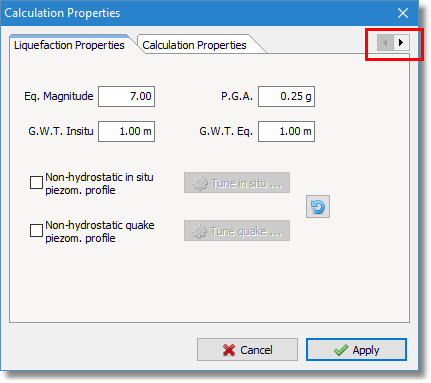In order to navigate to the various pages of the Calculation Properties dialog, you need to click on the arrow buttons located at the top right of the window as shown below

Calculation Properties dialog
Liquefaction Properties |
•Eq. Magnitude: The earthquake magnitude, Mw
•P.G.A.: Peak ground acceleration, Amax
•G.W.T. Insitu: The ground water table during test that will be used for the calculation of Cyclic Resistance Ratio, CRR
•G.W.T. Eq.: The ground water table during earthquake that will be used to calculate Cyclic Stress Ratio, CSR
•Non-hydrostatic in situ: When checked the Tune in situ ... button is enabled and allows to input pairs of depth, pore pressure that will be used to estimate in situ water pore pressure. The software will use linear interpolation for calculation depths that lay between the input values
•Non-hydrostatic quake: When checked the Tune quake ... button is enabled and allows to input pairs of depth, pore pressure that will be used to estimate water pore pressure during earthquake. The software will use linear interpolation for calculation depths that lay between the input values
Calculation Properties (SPT) |
•Calculation Method: The software supports the 2 most commonly used methods world wide, NCEER 1997 (with the recommendations from Youd et al. 2001) and Boulanger & Idriss 2014
•Sampling Method: Affects the calculation of sampling correction factor Cs
•Borehole Diameter: Affects the calculation of borehole correction factor Cb
•Rod length: Affects the calculation of rod correction factor Cr
•Hammer Energy Ratio: The software accepts the hammer energy correction factor Ce instead of the energy ratio
•Round corrected SPT: The software will estimate N60 and (N1)60 values as integer values so rounding method will affect calculated values, for example choosing to round up will result to higher SPT values thus this option is the less conservative.
•Cn formula: Overburden stress correction factor selection according to the suggestion in Youd et al. 2001
Calculation Properties (Vs) |
•Calculation Method: The software supports the 2 most commonly used methods world wide, NCEER 1997 and Kayen et al. 2013
Lateral Displacements |
•Level ground: If selected no calculation will be performed fro the estimation of lateral displacements
•Gently slope ground: Estimation of lateral displacements for gently slope ground according to Zhang et al. 2004. Applies only to NCEER liquefaction assessment method
•Level ground with free face: Estimation of lateral displacements for level ground with free face according to Zhang et al. 2004. Applies only to NCEER liquefaction assessment method
Other Properties |
•Default unit weight: Default unit weight value that will be used in case no value exists in the input data
•Water weight: Water weight value use in the calculations
•Dry sands settlements: If checked the software will try to estimate settlements above ground water table during earthquake according to Pradel 1998
•Limit γlim to 50%: A maximum limit on the limiting shear strain as suggested by Idriss & Boulanger 2008
•Eq. Ext. Load: External load that applies during earthquake at free surface. Can be used to model a fill